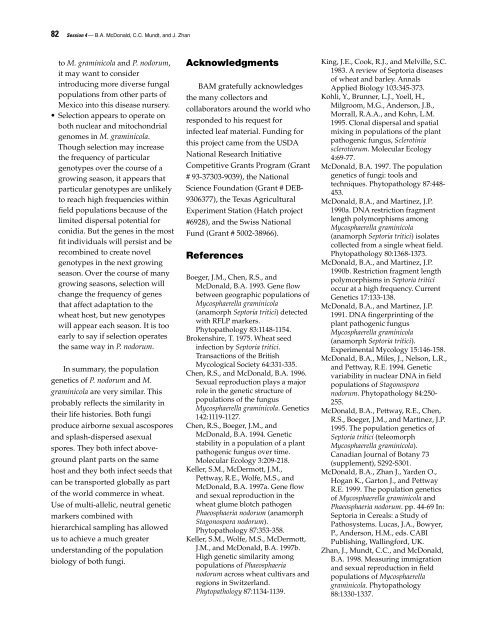Septoria and Stagonospora Diseases of Cereals - CIMMYT ...
Septoria and Stagonospora Diseases of Cereals - CIMMYT ...
Septoria and Stagonospora Diseases of Cereals - CIMMYT ...
You also want an ePaper? Increase the reach of your titles
YUMPU automatically turns print PDFs into web optimized ePapers that Google loves.
82<br />
Session 4 — B.A. McDonald, C.C. Mundt, <strong>and</strong> J. Zhan<br />
to M. graminicola <strong>and</strong> P. nodorum,<br />
it may want to consider<br />
introducing more diverse fungal<br />
populations from other parts <strong>of</strong><br />
Mexico into this disease nursery.<br />
• Selection appears to operate on<br />
both nuclear <strong>and</strong> mitochondrial<br />
genomes in M. graminicola.<br />
Though selection may increase<br />
the frequency <strong>of</strong> particular<br />
genotypes over the course <strong>of</strong> a<br />
growing season, it appears that<br />
particular genotypes are unlikely<br />
to reach high frequencies within<br />
field populations because <strong>of</strong> the<br />
limited dispersal potential for<br />
conidia. But the genes in the most<br />
fit individuals will persist <strong>and</strong> be<br />
recombined to create novel<br />
genotypes in the next growing<br />
season. Over the course <strong>of</strong> many<br />
growing seasons, selection will<br />
change the frequency <strong>of</strong> genes<br />
that affect adaptation to the<br />
wheat host, but new genotypes<br />
will appear each season. It is too<br />
early to say if selection operates<br />
the same way in P. nodorum.<br />
In summary, the population<br />
genetics <strong>of</strong> P. nodorum <strong>and</strong> M.<br />
graminicola are very similar. This<br />
probably reflects the similarity in<br />
their life histories. Both fungi<br />
produce airborne sexual ascospores<br />
<strong>and</strong> splash-dispersed asexual<br />
spores. They both infect aboveground<br />
plant parts on the same<br />
host <strong>and</strong> they both infect seeds that<br />
can be transported globally as part<br />
<strong>of</strong> the world commerce in wheat.<br />
Use <strong>of</strong> multi-allelic, neutral genetic<br />
markers combined with<br />
hierarchical sampling has allowed<br />
us to achieve a much greater<br />
underst<strong>and</strong>ing <strong>of</strong> the population<br />
biology <strong>of</strong> both fungi.<br />
Acknowledgments<br />
BAM gratefully acknowledges<br />
the many collectors <strong>and</strong><br />
collaborators around the world who<br />
responded to his request for<br />
infected leaf material. Funding for<br />
this project came from the USDA<br />
National Research Initiative<br />
Competitive Grants Program (Grant<br />
# 93-37303-9039), the National<br />
Science Foundation (Grant # DEB-<br />
9306377), the Texas Agricultural<br />
Experiment Station (Hatch project<br />
#6928), <strong>and</strong> the Swiss National<br />
Fund (Grant # 5002-38966).<br />
References<br />
Boeger, J.M., Chen, R.S., <strong>and</strong><br />
McDonald, B.A. 1993. Gene flow<br />
between geographic populations <strong>of</strong><br />
Mycosphaerella graminicola<br />
(anamorph <strong>Septoria</strong> tritici) detected<br />
with RFLP markers.<br />
Phytopathology 83:1148-1154.<br />
Brokenshire, T. 1975. Wheat seed<br />
infection by <strong>Septoria</strong> tritici.<br />
Transactions <strong>of</strong> the British<br />
Mycological Society 64:331-335.<br />
Chen, R.S., <strong>and</strong> McDonald, B.A. 1996.<br />
Sexual reproduction plays a major<br />
role in the genetic structure <strong>of</strong><br />
populations <strong>of</strong> the fungus<br />
Mycosphaerella graminicola. Genetics<br />
142:1119-1127.<br />
Chen, R.S., Boeger, J.M., <strong>and</strong><br />
McDonald, B.A. 1994. Genetic<br />
stability in a population <strong>of</strong> a plant<br />
pathogenic fungus over time.<br />
Molecular Ecology 3:209-218.<br />
Keller, S.M., McDermott, J.M.,<br />
Pettway, R.E., Wolfe, M.S., <strong>and</strong><br />
McDonald, B.A. 1997a. Gene flow<br />
<strong>and</strong> sexual reproduction in the<br />
wheat glume blotch pathogen<br />
Phaeosphaeria nodorum (anamorph<br />
<strong>Stagonospora</strong> nodorum).<br />
Phytopathology 87:353-358.<br />
Keller, S.M., Wolfe, M.S., McDermott,<br />
J.M., <strong>and</strong> McDonald, B.A. 1997b.<br />
High genetic similarity among<br />
populations <strong>of</strong> Phaeosphaeria<br />
nodorum across wheat cultivars <strong>and</strong><br />
regions in Switzerl<strong>and</strong>.<br />
Phytopathology 87:1134-1139.<br />
King, J.E., Cook, R.J., <strong>and</strong> Melville, S.C.<br />
1983. A review <strong>of</strong> <strong>Septoria</strong> diseases<br />
<strong>of</strong> wheat <strong>and</strong> barley. Annals<br />
Applied Biology 103:345-373.<br />
Kohli, Y., Brunner, L.J., Yoell, H.,<br />
Milgroom, M.G., Anderson, J.B.,<br />
Morrall, R.A.A., <strong>and</strong> Kohn, L.M.<br />
1995. Clonal dispersal <strong>and</strong> spatial<br />
mixing in populations <strong>of</strong> the plant<br />
pathogenic fungus, Sclerotinia<br />
sclerotiorum. Molecular Ecology<br />
4:69-77.<br />
McDonald, B.A. 1997. The population<br />
genetics <strong>of</strong> fungi: tools <strong>and</strong><br />
techniques. Phytopathology 87:448-<br />
453.<br />
McDonald, B.A., <strong>and</strong> Martinez, J.P.<br />
1990a. DNA restriction fragment<br />
length polymorphisms among<br />
Mycosphaerella graminicola<br />
(anamorph <strong>Septoria</strong> tritici) isolates<br />
collected from a single wheat field.<br />
Phytopathology 80:1368-1373.<br />
McDonald, B.A., <strong>and</strong> Martinez, J.P.<br />
1990b. Restriction fragment length<br />
polymorphisms in <strong>Septoria</strong> tritici<br />
occur at a high frequency. Current<br />
Genetics 17:133-138.<br />
McDonald, B.A., <strong>and</strong> Martinez, J.P.<br />
1991. DNA fingerprinting <strong>of</strong> the<br />
plant pathogenic fungus<br />
Mycosphaerella graminicola<br />
(anamorph <strong>Septoria</strong> tritici).<br />
Experimental Mycology 15:146-158.<br />
McDonald, B.A., Miles, J., Nelson, L.R.,<br />
<strong>and</strong> Pettway, R.E. 1994. Genetic<br />
variability in nuclear DNA in field<br />
populations <strong>of</strong> <strong>Stagonospora</strong><br />
nodorum. Phytopathology 84:250-<br />
255.<br />
McDonald, B.A., Pettway, R.E., Chen,<br />
R.S., Boeger, J.M., <strong>and</strong> Martinez, J.P.<br />
1995. The population genetics <strong>of</strong><br />
<strong>Septoria</strong> tritici (teleomorph<br />
Mycosphaerella graminicola).<br />
Canadian Journal <strong>of</strong> Botany 73<br />
(supplement), S292-S301.<br />
McDonald, B.A., Zhan J., Yarden O.,<br />
Hogan K., Garton J., <strong>and</strong> Pettway<br />
R.E. 1999. The population genetics<br />
<strong>of</strong> Mycosphaerella graminicola <strong>and</strong><br />
Phaeosphaeria nodorum. pp. 44-69 In:<br />
<strong>Septoria</strong> in <strong>Cereals</strong>: a Study <strong>of</strong><br />
Pathosystems. Lucas, J.A., Bowyer,<br />
P., Anderson, H.M., eds. CABI<br />
Publishing, Wallingford, UK.<br />
Zhan, J., Mundt, C.C., <strong>and</strong> McDonald,<br />
B.A. 1998. Measuring immigration<br />
<strong>and</strong> sexual reproduction in field<br />
populations <strong>of</strong> Mycosphaerella<br />
graminicola. Phytopathology<br />
88:1330-1337.









